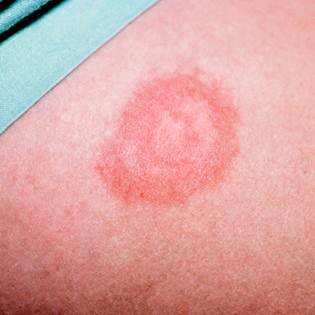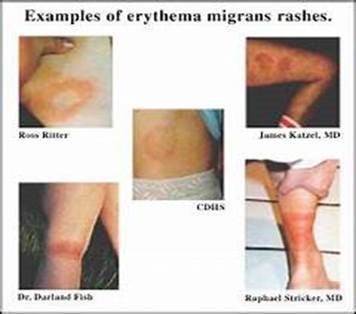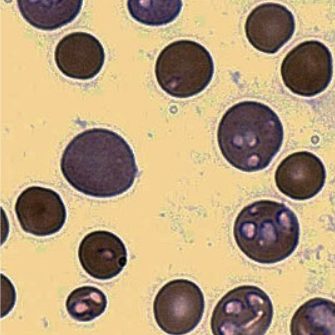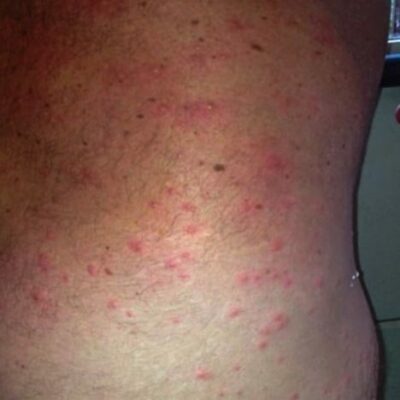Welcome to Babe Winkelman’s
Vector-Borne Disease Information Center
A complete guide on how you and your family can avoid the harmful and
sometimes deadly effects of Vector-borne diseases that can plague people’s lives for years!
MAJOR ILLNESSES CAUSE BY TICK BITES
Use the navigation bullets to learn more about major illnesses associated with tick bites.

Lyme Disease
Lyme disease was first discovered in 1973. Since then, the number of cases has dramatically increased over the years as well as the geographic distribution. People can become infected by bites from typically deer ticks, although recent studies have shown mosquitos and horse flies can have the spirochete (the bacteria that causes Lyme Disease) in them. It is not clear if they can transmit the disease.
Bottom line Inc. link: https://youtu.be/HqCO12PDCAA
There is a wide range of symptoms for Lyme disease, but a red bullseye rash is a dead giveaway that a person could be infected and needs to be tested ASAP. (40% of people do not see a rash & are still infected.) Lyme disease can show up on an ordinary blood test, but many times it does not. If you receive a negative test result, it could still be positive, since testing is highly inaccurate. This is a very complex & controversial disease.
Transmitted by:
- Deer Ticks
Symptoms/ Medical Complications:
- Gradual onset of (viral-like) symptoms.
- Multisystem–almost always, in the late stages includes joint pain plus cognitive dysfunction.
- Migrating Pain – first a knee will hurt, then over time this may lessen, and the elbow or shoulder acts up, and later the joints calm down, but headaches worsen.
- Stiff and loud joints, especially the neck (“Lyme shrug”).
- Headaches many times are associated with a stiff & painful neck.
- Many times, the morning body temperature is lower than normal and can rise to 99+ by early to mid-afternoon.
- There is typically a four-week cycle with Lyme where symptoms wax & wane and it repeats itself every 4 weeks. Keeping track of this can be helpful.
- There can be a slow response to treatment, with an initial symptom flare in most (“Herxheimer-like reaction”), then improvement over weeks. Monthly symptom flares can happen while being treated. If treatment is ended too soon, an initial improvement will gradually be replaced by a return of symptoms over a few weeks.
- A rash may not appear in up to around 40% of the patients. Many times, a rash can be on the scalp or somewhere difficult to see.
- Tiredness and limited stamina – often is a strong need to rest or even nap in the afternoon.
Printable Symptoms List Links:
Microsoft Word – DrB_SymptomList2005.doc (lymediseaseassociation.org)
Links for more information on Lyme Disease:
Lyme Disease Symptoms, Tests, and Treatment Options | RawlsMD
Lyme disease is knownto mimic auto immune disorders. This includes chronic fatigue syndrome (ME/CFS), Fibromyalgia, Rheumatoid Arthritis, Multiple Sclerosis (MS), or a Psychiatric illness like depression or anxiety. All these illnesses can be caused by Lyme, which is known as the “great imitator”.
These viruses can complicate testing & treatment of Lyme Disease & the co-infections.


*Tips: It can be very helpful to print a few symptoms lists and keep track each month of what is changing. It is also helpful to keep track of your temperature changes, especially when treating. (Any temperature change can help in the search of what infections you are fighting.)
*Herxheimer reaction is very helpful in successful treatment.
See Link for full list of possible symptoms:
What is a Herxheimer Reaction? What Can I Do About It? (holtorfmed.com)
These viruses can complicate testing & treatment of Lyme Disease & the co-infections.
Epstein Barr Virus,
HHV6 & CMV
Many people become infected with EBV in childhood. EBV infections in children usually do not cause symptoms, or the symptoms are not distinguishable from other mild, brief childhood illnesses. People who get symptoms from EBV infection, usually teenagers or adults, get better in two to four weeks. However, some people may feel fatigued for several weeks or even months. After you get an EBV infection, the virus becomes latent (inactive) in your body. In some cases, the virus may reactivate. This does not always cause symptoms, but people with weakened immune systems are more likely to develop symptoms if EBV reactivates.
- Persistent Fatigue – made worse with exercise.
- Sore throat, swollen lymph nodes, and other viral-like
complaints. - Possible elevated liver enzymes and low WBCs.
- Anxiety
- Dizziness
- Chest tightness
- Chest pain
- Esophageal spasms
- Asthma can also be caused by EBV inflaming the vagus nerve (the
main nerve reaching from the brain to the abdomen). - Insomnia, and tingling and numbness in hands and feet, can be
caused by phrenic nerves becoming inflamed by EBV.
Links for more information on Epstein-Barr syndrome:
Epstein-Barr Virus: A Key Player in Chronic Illness | RawlsMD
Babesiosis
Human Babesiosis is an infection like malaria and should be taken seriously since in some cases it has been fatal. It has been experimentally demonstrated that a bite from a single tick can transmit the pathogen. This illness destroys red blood cells and can cause a type of hemolytic anemia. This type of anemia leads to the yellowing of the skin and darkened urine.
Transmitted by:
- Deer Ticks

Human Babesiosis
Symptoms:
- Rapid onset of initial illness, often with sudden onset of high fever, severe headaches, sweats, and fatigue; thus it is easy to know when infection began.
- Obvious sweats, usually at night, but can be day sweats as well.
- Air hunger, need to sigh and take a deep breath, dry cough without apparent reason.
- Headaches can be severe–dull, global (involves the whole head, described like the head is in a vise).
- Fatigue is prominent, does not clear with rest, and is made worse with exercise.
- Mental dullness and slowing of reactions and responses.
- Dizziness–more like a tippy feeling, and not vertigo or purely orthostasis.
- Symptoms cycle rapidly, with flares every four to six days.
- Hypercoagulation is often associated with Babesia infections.
- Rarely, splenomegaly.
- Very severe Lyme disease can be a clue to Babesia infection, as it will make Lyme symptoms worse and Lyme treatments less effective.
Medical Complications
- Low or unstable blood pressure
- Severe hemolytic anemia
- Blood clots
- Malfunction of vital organs (kidneys, lungs, and liver)
Links for more information on Babesiosis:
Understanding Babesia: Symptoms, Testing, and Treatment | RawlsMD
5 Herbs that Can Kill Babesia: New Johns Hopkins Study | RawlsMD
Bartonellosis (Cat Scratch Fever)
Infection by any Bartonella species is called Bartonellosis. This species of bacteria is slow growing, comes in different shapes, and they can live in isolated locations in the body. The complexity of this bacteria protects it from the immune system and antibiotics. 40 different species have been recognized and a patient can harbor more than one of the species. Bartonellosis has over 22,000 cases reported each year. This number does not include the unreported cases. 1/3 of domestic cats are infected with these tick-borne microbes and many cases of transmission come from a scratch from an infected cat. The treatment for Bartonellosis can be different from the treatment of Lyme Disease.
Transmitted by:
- Hard & Soft shell ticks, fleas, mosquitos, biting flies, & red ants. *See video link below:
- Scratches from feral and domestic cats
May have papular or linear red rashes (like stretch marks that do not always follow skin planes), especially in those with GI involvement.
Links for more information on Bartonellosis:
* Bartonella video link with Dr Barrascano: https://youtu.be/M_tEMwZX5V4
Understanding Bartonella: Symptoms, Testing, and Treatment | RawlsMD
Symptoms:
- Gradual onset of initial illness.
- Central Nervous System symptoms are out of proportion to the musculoskeletal ones–if a patient has no or minimal joint complaints but is severely encephalopathic (see below), then think of Bartonella/BLO.
- Obvious signs of CNS irritability can include muscle twitches, tremors, insomnia, seizures, agitation, anxiety, severe mood swings, outbursts, and antisocial behavior.
- GI involvement may present as gastritis or abdominal pain (mesenteric adenitis).
- Sore soles, especially in the morning.
- Tender subcutaneous nodules along the extremities, especially outer thigh, shins, and occasionally along the triceps.
- Occasional lymphadenopathy.
- Morning fevers, usually around 99; occasionally light sweats are noted.
- Elevated vascular endothelial growth factor (VEGF) occurs in a minority, but the degree of elevation correlates with activity of the infection and may be used to monitor treatment.
- Rapid response to treatment changes–often symptoms improve within days after antibiotics are begun, but relapses occur also within days if medication is withdrawn early.
Links for more information on Bartonellosis
Unmasking Stealth Infections – The Bartonella Immunoblot with Dr. Joseph Burrascano (mnlyme.org)
Understanding Bartonella: Symptoms, Testing, and Treatment | RawlsMD
In MyLymeData, LymeDisease.org’s patient-led research project, 60% of patients with chronic symptoms of Lyme disease report co-infections. A previously published LymeDisease.org survey of over 3,000 patients found that over 50% had co-infections, with 30% of patients reporting two or more. Bartonella (28%) was the second most commonly reported co-infection associated with chronic Lyme disease. (Johnson, L., et al., 2014)
Anaplasmosis/Ehrlichiosis
Anaplasmosis is a tick-borne disease caused by the infectious bacterial organism Anaplasma phagocytophilum. It is transmitted through bites of the deer tick (also known as the black-legged tick) and western black-legged tick. A lesser form of anaplasmosis is caused by Anaplasma platys and is transmitted by the brown dog tick. Anaplasmosis has been reported worldwide in a wide variety of animals.Ehrlichiosis is the general name used to describe diseases caused by the bacteria Ehrlichia chaffeensis, E. ewingii, or E. muris eauclairensis in the United States. These bacteria are spread to people primarily through the bite of infected ticks including the lone star tick (Amblyomma americanum) and the blacklegged tick (Ixodes scapularis).
Transmitted by:
- The Black legged tick
- Brown Dog Tick
- Lone star tick
Symptoms/Medical Complications
- Rapid onset of initial illness with fever, headache, prostration.
- Headaches are sharp, knife-like, and often behind the eyes.
- Muscle pain, not joint pain, and can be mild or severe.
- Low WBC, low platelet count, elevated liver enzymes, and (rarely) inclusions seen in the WBCs.
- Rarely see diffuse vasculitis rash, including palms and soles (less than 10%).
- Rapid response to treatment.
Link for more information on Anaplasmosis/Ehrlichiosis:
Dangerous Tick Bites: 3 Tick-Borne Illnesses You Should Know About | RawlsMD
Rocky Mountain Spotted Fever
RMSF is a bacterial disease that can be fatal if not treated early and with the right antibiotic. The most common symptom in people who are infected with Rocky Mountain Spotted Fever is the rash that develops after infection. The look of the rash varies greatly from red splotches to small pinpoint dots. While nearly all people with RMSF develop a rash, it often does not become visible until the later stages, which makes it difficult to diagnose based on the rash alone.

Link for more information on RMSF:
Transmitted by:
- Lone Star Ticks
- American Dog Ticks
- Rocky Mountain Wood Tick
Symptoms and Medical Complications
- Rashes
- Fever
- Nausea
- Headache
- Stomach pain
Medical Conditions:
- Damage to blood vessels that can lead to amputation (arms, legs, fingers, or toes)
- Hearing loss
- Paralysis
- Mental disabilities
Powassan Virus
The Powassan Virus is a tick-borne disease that causes swelling of the brain itself, and the membranes around it. There have only been 100 cases in the last 10 years. However, experts predict that the Powassan virus will spread more quickly due to the virus recently spreading to the deer tick population. This species is significantly more likely to bite humans. In the past, it was only carried by tick species that rarely ever bit humans.
Transmitted by:
- blacklegged deer tick
- groundhog tick
- squirrel tick
Symptoms:
-
Main symptoms: fever, weakness, headache, vomiting, encephalitis, cognitive impairment, loss of coordination, seizures, speech difficulties
DOWNLOAD THE POWASSAN VIRUS GUIDE (PDF)
Link for more information on Powassan Virus:
Should You Worry about Powassan Virus? Here’s What You Need to Know | RawlsMD
Mycoplasma
Mycoplasma is spread by biting insects (ticks, mosquitoes, fleas, biting flies), sexual contact, contaminated food, and airborne droplets. Most everyone has been exposed to some form of mycoplasma. Several mycoplasma species have been closely associated with many chronic degenerative diseases like multiple sclerosis and Alzheimer’s disease, according to publications like the International Reviews of Immunology and the British Journal of Medical Practitioners.
Transmitted by:
- Biting insects (ticks, mosquitoes, fleas, biting flies)
Symptoms:
- Gradual onset.
- May be light night sweats.
- Symptoms are made worse with exercise.
- Major fatigue and neurological dysfunction, especially autonomic neuropathies.
- Metabolic disturbances, immune damage, very low CD57 count (less than 20).
- Found in the sickest and most poorly responding Lyme patients (CFIDS-like).
- Sore throat, Fever, Headache, Malaise, Runny nose, bronchitis, and sometimes walking pneumonia
Links for more information on Mycoplasma:
Mycoplasma: The #1 Lyme Coinfection + How to Outsmart It | RawlsMD
Sorting out Lyme and Associated Coinfections By Dr. Joseph Burrascano (lymedisease.org)
Alpha Gal (Red Meat Allergy)
Alpha-gal (Red Meat Allergy) is a condition discovered in 2006 that has been linked to Lone Star ticks. Alpha-gal is a carbohydrate molecule that can cause an allergic reaction when people consume red meat. The Lone Star tick is not the only cause but accounts for 80% of all cases. The allergic reactions/symptoms can be difficult to link to a meat allergy because it can take 3-5 hours after consuming red meat for the person to develop the life-threatening symptoms such as anaphylaxis. The first line of treatment for serious allergic reactions is epinephrine which is available on prescription as an auto-injector.
Transmitted by:
- Lone Star Ticks
Symptoms:
- Outbreak of hives
- Anaphylaxis
- Nausea
- Severe headaches
- Shortness of breath
- Diarrhea
Medical Complications
- Restriction of breathing (Can be fatal in extreme cases)
- Asthma
- Abnormal heart rate
Alpha-Gal Syndrome: How to Diagnose, Treat, and Prevent It | RawlsMD
